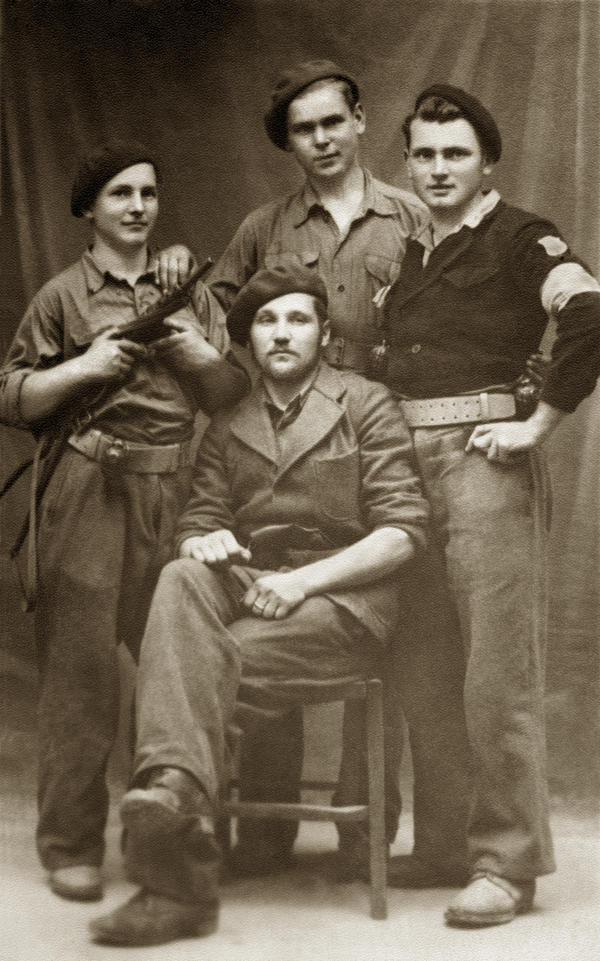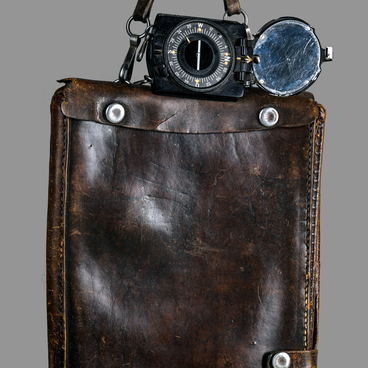Members of the French Resistance: the escaped prisoner of war P.I. Reznikov (seated), and his bothers in arms (left to right) Viktor from Dnepropetrovsk, Pyotr, and Pierre from Alsace. Périgord (France)
One of the men in the photograph, Pavel Ivanovich Reznikov (24.12.1921 – 11.09.1987) lived in Chelyabinsk before the war. He was conscripted into the Field Army. On the front he was captured and became a prisoner of war. In summer 1944 he escaped from his prisoner of war camp, in Northern France, and joined the French Resistance. In mid 1944 up to 20 000 Soviet patriots, organized into 55 partisan divisions and many smaller groups, were fighting in France. Pavel Ivanovich Reznikov fought in the Alsace-Lorraine partisan brigade. In his memoirs he wrote: ‘More then one and a half months have gone by… the Germans have stopped patrolling this district (the forest of Verdun) - if the patrols come here at all it is only with a heavy guard.’ In June the fascists tried to destroy the partisans. During a fight which lasted an entire night, they attacked with flame throwers, mortars and machine guns. The division suffered heavy losses, but by the end of July it had grown in strength to 1 500 fighters. The division was reformed, becoming the Alsace-Lorraine partisan brigade, and took part in attacks on the fascists. The brigade liberated towns in the Périgord and Angoulême regions. In October 1944, when the brigade was near Strasbourg, Pavel Ivanovich Reznikov made his way to Paris, where the Soviet military mission helped him return to the USSR. After his return from France he continued to serve in the Soviet army. Then he lived in Omsk until 1958, working as a senior mechanic in assembly division No. 3 at Neftezavodmontazh. In 1958 he moved to our city. The partisan beret worn by Pavel Ivanovich Reznikov is also in the exhibition.
The weapons which can be seen in the photograph are both British-made: a STEN submachine gun and a Mills bomb. The British army supplied up to 500 000 STEN submachine guns to Resistance fighters in occupied Europe.
It turned out that clashes between infantry during the Second World War typically occurred at a range of no more than 350 meters, with most of the fighting with light firearms taking place at 250 meters or less, much closer than had been assumed in the period before the war. The submachine gun was a highly effective weapon at this range.
During the Second World War, STEN submachine guns were issued to and used by the British Army, and were also supplied to a number of other Allied armies.
The grenade, seen from the outside, is an oval ribbed shell made of iron. When it explodes the grenade breaks up along the horizontal and vertical grooves, forming fragments of a uniform mass and size. The case of the grenade is 6 millimeters thick.
To prepare the bomb for use the base plug was unscrewed, the detonator assembly was inserted, and the plug screwed back on. To use the bomb, the thrower took it in his right hand and pressed down the lever, while gripping the safety pin with the left hand and tugging on the ring to pull out the pin from the hole in the lever. He would then throw the grenade at the target and take cover. It would explode within 5-7 seconds.
One of the men in the photograph, Pavel Ivanovich Reznikov (24.12.1921 – 11.09.1987) lived in Chelyabinsk before the war. He was conscripted into the Field Army. On the front he was captured and became a prisoner of war. In summer 1944 he escaped from his prisoner of war camp, in Northern France, and joined the French Resistance. In mid 1944 up to 20 000 Soviet patriots, organized into 55 partisan divisions and many smaller groups, were fighting in France. Pavel Ivanovich Reznikov fought in the Alsace-Lorraine partisan brigade. In his memoirs he wrote: ‘More then one and a half months have gone by… the Germans have stopped patrolling this district (the forest of Verdun) - if the patrols come here at all it is only with a heavy guard.’ In June the fascists tried to destroy the partisans. During a fight which lasted an entire night, they attacked with flame throwers, mortars and machine guns. The division suffered heavy losses, but by the end of July it had grown in strength to 1 500 fighters. The division was reformed, becoming the Alsace-Lorraine partisan brigade, and took part in attacks on the fascists. The brigade liberated towns in the Périgord and Angoulême regions. In October 1944, when the brigade was near Strasbourg, Pavel Ivanovich Reznikov made his way to Paris, where the Soviet military mission helped him return to the USSR. After his return from France he continued to serve in the Soviet army. Then he lived in Omsk until 1958, working as a senior mechanic in assembly division No. 3 at Neftezavodmontazh. In 1958 he moved to our city. The partisan beret worn by Pavel Ivanovich Reznikov is also in the exhibition.
The weapons which can be seen in the photograph are both British-made: a STEN submachine gun and a Mills bomb. The British army supplied up to 500 000 STEN submachine guns to Resistance fighters in occupied Europe.
It turned out that clashes between infantry during the Second World War typically occurred at a range of no more than 350 meters, with most of the fighting with light firearms taking place at 250 meters or less, much closer than had been assumed in the period before the war. The submachine gun was a highly effective weapon at this range.
During the Second World War, STEN submachine guns were issued to and used by the British Army, and were also supplied to a number of other Allied armies.
The grenade, seen from the outside, is an oval ribbed shell made of iron. When it explodes the grenade breaks up along the horizontal and vertical grooves, forming fragments of a uniform mass and size. The case of the grenade is 6 millimeters thick.
To prepare the bomb for use the base plug was unscrewed, the detonator assembly was inserted, and the plug screwed back on. To use the bomb, the thrower took it in his right hand and pressed down the lever, while gripping the safety pin with the left hand and tugging on the ring to pull out the pin from the hole in the lever. He would then throw the grenade at the target and take cover. It would explode within 5-7 seconds.



